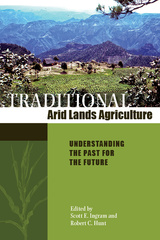
352 pages, 6 x 9
35 b&w illustrations, 12 color illustrations, 15 tables
Paperback
Release Date:02 Jul 2018
ISBN:9780816539338
Trincheras Sites in Time, Space, and Society
SERIES:
The University of Arizona Press
The intriguing hilltop archaeological sites known as cerros de trincheras span almost three millennia, from 1250 BC to AD 1450. Archaeologists have long viewed them as a unitary phenomenon because they all have masonry architecture and occur mostly on low volcanic peaks. Scattered across the southwestern United States and northwestern Mexico, these sites received little comprehensive research until the 1980s. This first volume in the Amerind Studies in Archaeology series from the Amerind Foundation documents considerable variability among trincheras sites with respect to age, geographic location, and cultural affiliation.
This multi-author volume integrates a remarkable body of new data representing a textbook-like array of current research issues and methodologies in the archaeology of the region. Scholars from the United States and Mexico offer original research on trincheras sites in Chihuahua, Sonora, Arizona, and New Mexico. Scales of focus range from intensive intrasite sampling to the largest contiguous survey in the region. Authors incorporate spatial analyses, artifact studies, environmental and subsistence data, ethnographic analogs, ethnohistorical records, cross-cultural comparisons, archaeology, and archival resources.
The volume’s discussions contribute innovative approaches to worldwide interpretations of landscapes marked by hilltop sites. Contributors present meticulous research arguing that many trincheras sites were primarily used for habitation and ceremonial rites, in addition to previously predominant views of them as defensive refuges. Because trincheras occupations date from the late preceramic era to shortly before Spanish contact, authors relate them to early forms of agriculture, the emergence of village life, the appearance of differentiated settlement systems, and tendencies toward political and ritual centralization.
Detailed maps and figures illustrate the text, and close-up aerial photographs capture the visual essence of the sites, highlighted by a section that includes color photographs and an essay by renowned photographer Adriel Heisey.
Contributors:
Christian E. Downum
Paul R. Fish
Suzanne K. Fish
Robert J. Hard
Adriel Heisey
Stephen A. Kowalewski
Randall H. McGuire
Ben A. Nelson
John R. Roney
Judith Taylor
M. Elisa Villalpando
Joseph Vogel
Henry Wallace
David R. Wilcox
J. Scott Wood
This multi-author volume integrates a remarkable body of new data representing a textbook-like array of current research issues and methodologies in the archaeology of the region. Scholars from the United States and Mexico offer original research on trincheras sites in Chihuahua, Sonora, Arizona, and New Mexico. Scales of focus range from intensive intrasite sampling to the largest contiguous survey in the region. Authors incorporate spatial analyses, artifact studies, environmental and subsistence data, ethnographic analogs, ethnohistorical records, cross-cultural comparisons, archaeology, and archival resources.
The volume’s discussions contribute innovative approaches to worldwide interpretations of landscapes marked by hilltop sites. Contributors present meticulous research arguing that many trincheras sites were primarily used for habitation and ceremonial rites, in addition to previously predominant views of them as defensive refuges. Because trincheras occupations date from the late preceramic era to shortly before Spanish contact, authors relate them to early forms of agriculture, the emergence of village life, the appearance of differentiated settlement systems, and tendencies toward political and ritual centralization.
Detailed maps and figures illustrate the text, and close-up aerial photographs capture the visual essence of the sites, highlighted by a section that includes color photographs and an essay by renowned photographer Adriel Heisey.
Contributors:
Christian E. Downum
Paul R. Fish
Suzanne K. Fish
Robert J. Hard
Adriel Heisey
Stephen A. Kowalewski
Randall H. McGuire
Ben A. Nelson
John R. Roney
Judith Taylor
M. Elisa Villalpando
Joseph Vogel
Henry Wallace
David R. Wilcox
J. Scott Wood
A very interesting read, not only for Southwest U.S./Northwest Mexican researchers, but also for archaeologists interested in how data are used to make inferences. . . . The chapters are well written and the photographs of many of the trincheras sites by Adriel Heisey are spectacular.’—Journal of Anthropological Research
‘Well researched, this book represents the latest and most current research on cerros de trincheras located in the international four corners area (Arizona, New Mexico, Sonora, and Chihuahua) and forms an important scholarly contribution. . . . Without a doubt, this volume is a ‘must read’ for those who work in Northwest Mexico and the U.S. Southwest.’—Kiva
‘This edited volume integrates a remarkable body of new data representing current issues and methodologies in the archaeology of hilltop sites.’—SMRC Revista
‘This book is important for scholars interested in trincheras sites and the archaeology of the international four corners.’—Journal of Field Archaeology
‘Should be of interest to geographers concerned with historical themes in the nature-society tradition. . . . This volume is a thorough, up-to-date, and insightful treatise on research dealing with cerros de trincheras.’—Geographical Review
‘This book is likely to become one of the staples of southwestern archaeology.’—David Phillips, University of New Mexico
‘Knowledge of trincheras sites has expanded dramatically, and this volume is a timely exposition of the major advances.’—Stephen Lekson, University of Colorado
Suzanne K. Fish is Curator of Archaeology at the Arizona State Museum and Professor of Anthropology at the University of Arizona. She is the co-author (with Paul R. Fish) of The Marana Community in the Hohokam World, published by the University of Arizona Press.
Paul R. Fish is Curator of Archaeology at the Arizona State Museum and Professor of Anthropology at the University of Arizona.
M. Elisa Villalpando holds the position of Investigadora with the Centro Regional Sonora of the Instituto Nacional de Antropología e Historia.
Paul R. Fish is Curator of Archaeology at the Arizona State Museum and Professor of Anthropology at the University of Arizona.
M. Elisa Villalpando holds the position of Investigadora with the Centro Regional Sonora of the Instituto Nacional de Antropología e Historia.






